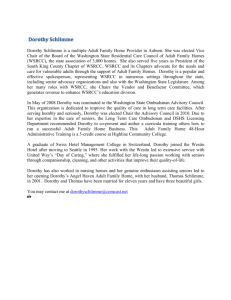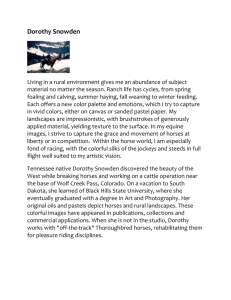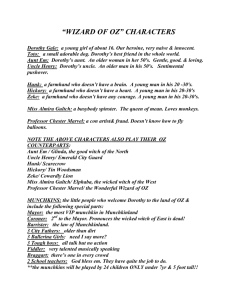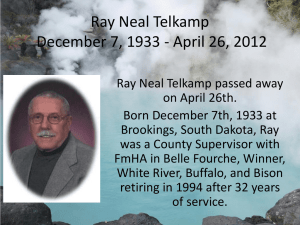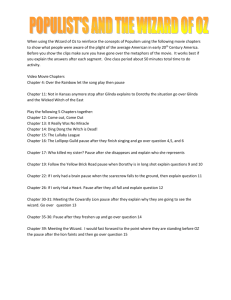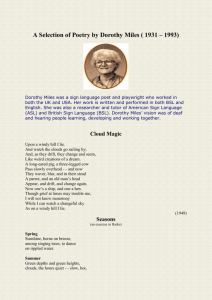the wizard of oz - Deutsches Filminstitut
advertisement
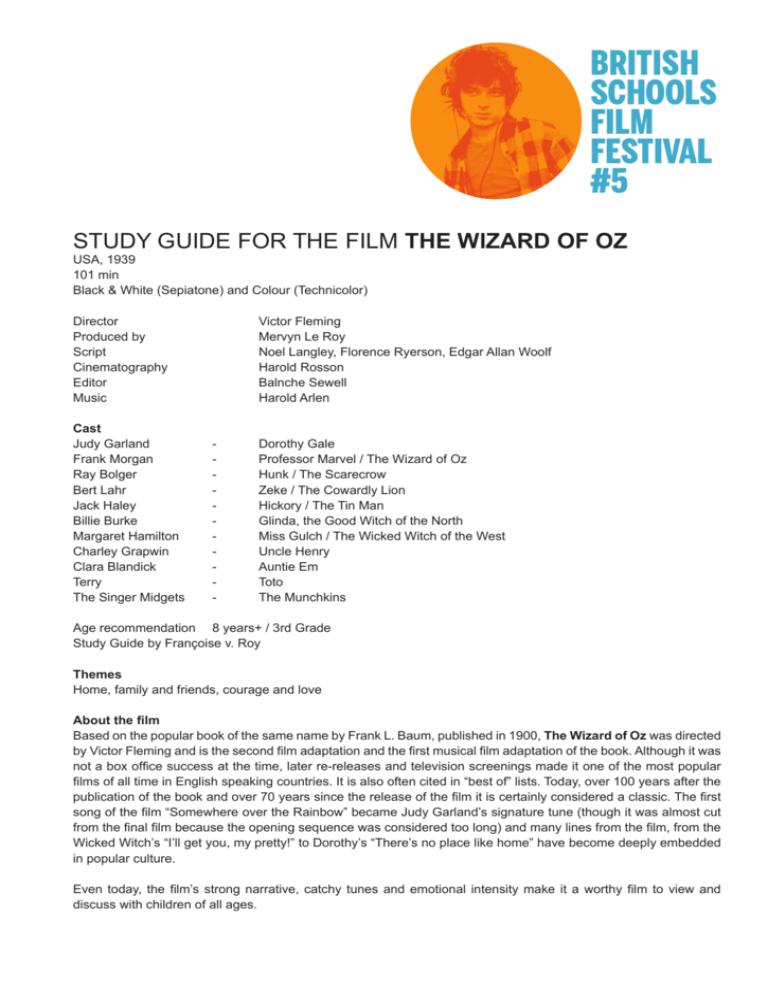
BRITISH SCHOOLS FILM FESTIVAL #5 STUDY GUIDE FOR THE FILM THE WIZARD OF OZ USA, 1939 101 min Black & White (Sepiatone) and Colour (Technicolor) DirectorVictor Fleming Produced by Mervyn Le Roy Script Noel Langley, Florence Ryerson, Edgar Allan Woolf Cinematography Harold Rosson EditorBalnche Sewell MusicHarold Arlen Cast Judy Garland - Dorothy Gale Frank Morgan - Professor Marvel / The Wizard of Oz Ray Bolger - Hunk / The Scarecrow Bert Lahr - Zeke / The Cowardly Lion Jack Haley - Hickory / The Tin Man Billie Burke - Glinda, the Good Witch of the North Margaret Hamilton - Miss Gulch / The Wicked Witch of the West Charley Grapwin - Uncle Henry Clara Blandick - Auntie Em Terry-Toto The Singer Midgets - The Munchkins Age recommendation 8 years+ / 3rd Grade Study Guide by Françoise v. Roy Themes Home, family and friends, courage and love About the film Based on the popular book of the same name by Frank L. Baum, published in 1900, The Wizard of Oz was directed by Victor Fleming and is the second film adaptation and the first musical film adaptation of the book. Although it was not a box office success at the time, later re-releases and television screenings made it one of the most popular films of all time in English speaking countries. It is also often cited in “best of” lists. Today, over 100 years after the publication of the book and over 70 years since the release of the film it is certainly considered a classic. The first song of the film “Somewhere over the Rainbow” became Judy Garland’s signature tune (though it was almost cut from the final film because the opening sequence was considered too long) and many lines from the film, from the Wicked Witch’s “I’ll get you, my pretty!” to Dorothy’s “There’s no place like home” have become deeply embedded in popular culture. Even today, the film’s strong narrative, catchy tunes and emotional intensity make it a worthy film to view and discuss with children of all ages. Synopsis Dorothy Gale lives on a farm in Kansas with her Auntie Em, Uncle Henry, her dog, Toto, and the three farmhands: Zeke, Hickory and Hunk. We meet Dorothy for the first time, frantic with worry, running towards the farm with Toto. A bad-tempered neighbour, Miss Gulch, has threatened to take Toto away because he chased her cat and bit her. Auntie Em and Uncle Henry are too busy to listen to Dorothy’s worries and so Dorothy confides in Hickory, Hunk and Zeke. Each of them tries to give Dorothy advice until Auntie Em tells her to find a place where she won’t get into trouble. Dorothy wonders where such a place could be, “Behind the moon, beyond the rain… Somewhere over the rainbow…” Miss Gulch arrives on her bicycle with the sheriff’s permission to take Toto. Auntie Em and Uncle Henry defend Dorothy and the little dog, but when Miss Gulch threatens to have their farm taken away if they don’t comply, they acquiesce. Miss Gulch leaves with Toto, but Toto manages to escape from the basket on the back of Miss Gulch’s bike and returns to Dorothy, who decides to run away with Toto, so he can’t be taken away again. Not long on the road, they come upon a caravan, lived in by Professor Marvel. Suspecting that Dorothy has run away from home, Professor Marvel offers to tell Dorothy her fortune. Peeking into her basket, he finds a photograph of Dorothy and Aunt Em, and so when he peers into his crystal ball, Professor Marvel tells Dorothy that he sees an elderly woman at a farm, sick with worry, because someone dear to her has broken her heart. Believing Professor Marvel, Dorothy rushes back home. Strong winds announce the arrival of a cyclone heading directly to the farm. Uncle Henry and the farmhands force Aunt Em in to the storm shelter, though she looks and calls out for Dorothy. Dorothy arrives home, just as the others have locked themselves in the safety of the shelter. She takes cover in her bedroom, where she is knocked unconscious by a window frame, torn off its hinges by the storm. When she awakens, Dorothy sits up in her bed and sees all sorts of peculiar things rushing past her window: a henhouse, a woman in a rocking chair, two men rowing in a boat, even Miss Gulch on her bicycle, who transforms into a witch before Dorothy’s eyes. Dorothy steps up to the window and sees that she’s inside the cyclone. Suddenly the house drops a great distance. When Dorothy opens the front door, she and the audience are met with the bright Technicolour of the magical land of Oz. Dorothy immediately recognizes she is no longer at home: “I have feeling we are not in Kansas anymore.” Dorothy says to Toto. “We must be over the rainbow.” Glinda, the Good Witch of the North, appears asking Dorothy if she is a good witch or a bad witch. It turns out that Dorothy’s house dropped on the Wicked Witch of the East, killing her. The Munchkins, inhabitants of Munchkinland, rejoice, singing “Ding Dong! The Witch is Dead.” The festivities are interrupted by the arrival of the Wicked Witch of the West, who seeks the person responsible for her sister’s death and wants to claim the Wicked Witch of the East’s ruby slippers. Glinda flicks her magic wand and the ruby slippers appear on Dorothy’s feet. For now the Wicked Witch of the West can not harm Dorothy and she departs, threatening to get Dorothy and Toto. Glinda recommends Dorothy leave Oz as soon as possible and not to remove the ruby slippers as long as she is in Oz. Since Dorothy does not know how to return to Kansas, Glinda suggests asking the Wizard of Oz, who lives in the Emerald City. In order to get there, Dorothy must simply “follow the Yellow Brick Road”. On her way, Dorothy meets the Scarecrow, the Tin Man and the Cowardly Lion. Each one feels deficient in some way; the Tin Man thinks he has no heart, the Scarecrow believes he has no brain and the Lion feels he lacks courage. To each one, Dorothy suggests joining her to ask the Wizard of Oz for help. On their journey along the Yellow Brick Road the Wicked Witch appears, threatening the group, but only strengthens Dorothy’s new companions in their resolve to make sure she makes it to the Emerald City safely. From her castle, the Wicked Witch conjures up a field of poppies to put Dorothy and her friends to sleep. Indeed, Dorothy and the Lion fall deeply asleep amidst the beguiling flowers, but the Tin Man and the Scarecrow’s cries for help are heard by Glinda, who sends a snow storm over the field of poppies, which awakens Dorothy and the Lion. The group arrives at the gates of Emerald City. The guard lets them in when he sees that Dorothy is wearing the ruby slippers, but tells them that no one has ever seen the Wizard of Oz. Eventually Dorothy and her companions are granted an audience with the Wizard, who appears as a disembodied, giant head, offset by plumes of colourful smoke. After frightening the group with his booming voice, the Wizard promises that he will grant their requests, only if they bring him the broomstick of the Wicked Witch of the West. Though frightened, Dorothy and her friends make their way through the haunted forest to the Witch’s castle. Watching their approach in her crystal ball, the Witch orders her army of winged monkeys to capture Dorothy and Toto. The flying monkeys chase the friends apart and, snatching Dorothy and Toto, fly back to the castle. After the Witch bullies Dorothy into giving up the ruby slippers, by threatening to throw Toto into the river, they discover that the slippers can not be removed as long as Dorothy is alive. The Witch produces an hourglass and proclaims that Dorothy will live only as long as the sand hasn’t run through. Toto escapes to the forest and after finding the Lion, Scarecrow and the Tin Man, he shows them the way to the castle. They break into the room in which Dorothy is held captive, but before they can escape the Witch’s guards cornered them. After the Witch sets flame to the Scarecrow, Dorothy throws a bucket of water over him, accidentally splashing the Witch, who melts away before them. In a gesture of thanks for ridding them of the Wicked Witch of the West the guards allow Dorothy to take the Witch’s broomstick. Back in Emerald City, Dorothy and her friends appear before the Wizard with the broom. Surprised they were able to defeat the Wicked Witch, the Wizard tells them to go away and come back tomorrow. While the group begs him to fulfill the promises he made, Toto pulls a curtain aside, revealing a man pulling and pushing knobs and levers and speaking into a microphone. He appears to be the voice of the Wizard and creator of the head projection and smoke effects. After being confronted by Dorothy and the others he admits pretending to be a wizard. The friends berate him for breaking his promises, but the Wizard suggests that what they requested from him, they have had all along. He gives the Scarecrow, the Tin Man and the Cowardly Lion symbolic tokens representing the virtues they displayed on their adventure. The Wizard confides that he arrived in Oz accidentally in a hot air balloon, all the way from Kansas. He still has the balloon and could transport Dorothy back home in it. Just as they are about to leave, Toto jumps from Dorothy’s arms and chases after a cat, forcing Dorothy to leave the balloon’s basket. The balloon is accidentally released and the Wizard sets off with out Dorothy. As Dorothy weeps, the Good Witch Glinda appears and explains to her that she has always had the power to get home, but that she has to learn it for herself. When the Tin Man asks Dorothy what it is that she has learned, she says: “…if I ever go looking for my heart’s desire again, I won’t look any further than my own backyard; because if it isn’t there, I never really lost it to begin with!” Dorothy bids farewell to her friends and Glinda instructs her to close her eyes, tap her heels together and think to herself: “There’s no place like home.” After following Glinda’s instructions, Dorothy finds herself back home in her own bed surrounded by family and friends. She tells them of her adventures and promises never to run away again because she loves them all so much and because: “There’s no place like home.” Themes / Topics (see also accompanying worksheets at the end of the document) Home Dorothy’s adventure begins when she runs away to avoid Toto being taken away, though she returns fearing for her aunt’s well being, the cyclone does transport her away, to the mythical land of Oz. Despite having dreamed of a place “Somewhere over the rainbow”… “where troubles melt like lemon drops.” once in Oz, all Dorothy wants to do is to return home. Only when she is far away from home does she realize how important home, family and friends are to her. Although for some viewers the colourful, magical Oz may seem more attractive than the bleak black and white images of Dorothy’s farm, we all root for Dorothy to make it back. The use of sepia-toned black and white film for the opening and closing scenes of the films, intensifies the dreariness of Depression-era Kansas and provides a strong contrast to the vibrant Oz, shot in Technicolour. Dorothy retains one constant reminder of home, one that even sticks to the colour scheme, and that is Toto, the only character who stays gray (his natural colour) in Oz! There are other reminders of home in this magical place. Several of the characters that Dorothy meets along the Yellow Brick Road have counterparts in Kansas. The three farmhands, Hunk, Hickory and Zeke, are played by the same actors who play the Scarecrow, the Tin Man and the Cowardly Lion. They even display similar characteristics, with Zeke (the Cowardly Lion) being so easily frightened when Dorothy falls into the pig pen and Hunk (the Scarecrow) telling Dorothy to use her brains, whilst he clumsily smacks his thumb with a hammer. (More on this below, in the Journey section.) When Dorothy wakes up at home, she sees them at her bedside and exclaims wide-eyed that they were with her while she was away. Professor Marvel also appears at Dorothy’s bedside, although he is not part of Dorothy’s family or close friends, he does provide her with the friendly impetus to return home when she first ran away. This character also has a counterpart in Oz, in fact not one, but four: the Wizard, the Emerald City Gatekeeper, Guard and Coachman. Although, it is never mentioned in the film, we can presume that Dorothy is an orphan. Her aunt and uncle are her family. When we first meet them they are too busy trying to save chicks to listen to Dorothy’s woes. However, when we see their reaction to cantankerous Miss Gulch and her attempt to wrench Toto away from Dorothy and when we hear Dorothy describe her aunt to Professor Marvel, we know that Aunt Em and Uncle Henry love Dorothy deeply. Finally, as previously mentioned, the phrase “There’s no place like home” has become part of popular culture; more importantly, it is one of the main messages of the film contained, rather elegantly, in one simple sentence. The Journey Journeys provide clear narrative structures for many films and stories, from The Odyssey, The NeverEnding Story to The Golden Compass. Dorothy’s journey along the Yellow Brick Road can be seen as the adventure it is, as well as the journey that allows her to learn what she needs to return home. Other meanings can be contributed to this voyage, for example, it can also be interpreted as a metaphor for Dorothy’s coming of age, the beginning of her transition from childhood into adulthood or the understanding that although all children eventually strive for independence from home and family, many may still long for the familiarity and safety of home, which even adults do too. As with any great journey, the heroine, Dorothy, must overcome many obstacles (the Angry Trees, the Field of Deathly Poppies, the mission to claim the Wicked Witch’s broomstick); she meets some characters who will help her on her quest (the Good Witch Glinda, the Scarecrow, Tin Man and the Cowardly Lion) and some who will hinder her (the Wicked Witch, the flying monkeys, even the Wizard to some extent). Dorothy’s own voyage has its parallels in the quests of the three characters she meets on the Yellow Brick Road. Each believes he is deficient in some way. The Tin Man thinks he is missing a heart, the Scarecrow believes he is missing a brain and the Lion feels he has no courage. They all think they need the Wizard to obtain what they lack, just like Dorothy hopes the Wizard will be able to tell her how to get back to Kansas. In the end, they all discover they had what they needed all along, as the Wizard explains before he gives them the tokens of their virtues. During the journey along the Yellow Brick Road, each of the three has demonstrated this. The Scarecrow proposes several good ideas, the Tin Man has empathized with Dorothy from the get-go and the Cowardly Lion, though frightened, displayed courage. Glinda, the Good Witch, tells Dorothy she can get home all on her own if only she believes she can, which is what Dorothy does in the end. This recognition of self-confidence and self-reliance and the realisation that what is needed could be found in your “own backyard.”; though it often takes an outside event, such as a cyclone, to bring about recognition, can also be seen as what Dorothy learns on her journey. Genre The Wizard of Oz is a classical musical of the late 1930s, early 1940s Hollywood. Other early classic examples are: Singing in the Rain and Meet Me in St. Louis. As a genre, the musical was born in the years of the Great Depression in the U.S.A. (Martin Scorcese calls musicals “The most escapist of all film genres”). There is naturally a certain degree of suspension of disbelief that occurs when the characters in a film begin to sing and dance outside of the usual context of song and dance and perhaps this combined well with the audience’s need to escape their worldly worries. At the same time theatrical musicals were very well liked in the 1920s and film musicals provided an extension of this popular form of entertainment. The early 60s still produced The Sound of Music and Mary Poppins, but the cultural and musical developments in that decade shifted musicals away from the more traditional sounding show tunes. Later examples of film musicals include such varied titles as: Grease, The Rocky Horror Picture Show and Moulin Rouge. On the whole, though, it can be said that the popularity of musicals has steadily decreased over the years (although TV series seem to have discovered the musical episode). Today, musicals are much less common, especially film musicals for a young or family audience, with the notable exception here being animation. Most animated family films produced regularly by Disney are musicals, a very recent example is Tangled, a musical reworking of Rapunzel. Disney also produced the live-action films: High School Musical 1-3, but here the song and dance numbers are contained within a musical context, the plots revolve around a school musical, talent show or similar. Songs in musicals function to express or intensify the emotions of a scene or character, to convey meaning, comment on events or even to further the plot. In The Wizard of Oz the songs mostly occur in scenes with strong emotional content, for example, Somewhere over the Rainbow, when Dorothy longs for “someplace where there isn’t any trouble” or Ding Dong! The Witch is Dead when the Munchkins rejoice at the death of the Wicked Witch of the East. Probably the other most significant element of classical musicals is dance. Each song has a tightly choreographed dance routine. In The Wizard of Oz this is most obvious in scenes with a large cast, for example, one hundred and twenty Munchkins singing “Ding Dong! The Witch is Dead” or when Dorothy and her companions arrive in Emerald City and they and all inhabitants of the city sing “The Merry Old Land of Oz”, but even Dorothy’s happy skip to “Follow the Yellow Brick Road”, is choreographed. Perhaps not so obvious, but also characteristic of classical musicals, is the more theatrical set and costume design. Of course, sets and costumes are designed and specially selected for all fiction films, but classical musical sets and costumes are closer to their theatrical counterparts than other films. Especially in The Wizard of Oz, there is a brightness and vibrancy to the selection of the colours used, which of course is accentuated by the use of Technicolour film. A final detail, regarding costume design: Dorothy’s slippers were originally silver, but the producer changed them to red to fully take advantage of the use of colour film, thus, they became the emblematic ruby red slippers. List of difficult words: Twister or cyclone - a storm with very strong winds that forms a funnel from the sky down to earth. In the film it lifts Dorothy’s house and transports it to Oz. Scarecrow - A scarecrow is made of straw and dressed in clothes to look like a person. It is set up in fields to scare away birds, so they don’t eat the crops from the fields. Coward - someone who is not brave and easily frightened. In The Wizard of Oz, the Lion is sometimes called the Cowardly Lion. Courage - If you are brave, you have courage. The Lion thinks he has no courage. Wizard - someone who has magical powers, like a witch. WAS IST BRITFILMS? BRITFILMS ist eine Schulfilmreihe der AG Kino-Gilde, Verband der Programmkinos und Filmkunsttheater in Deutschland. Sechs englischsprachige Filme touren 16 Monate lang durch die deutschen Kinos und werden von den Kinobetreibern in Schulvorfuhrungen fur Kinder im Alter von 8-18 Jahren eingesetzt. Die Vorfuhrungen können direkt in den teilnehmenden Kinos gebucht werden. Begleitend werden Fortbildungen/Filmpreviews fur Englischlehrer und – lehrerinnen angeboten. Ebenso gibt es als pädagogisches Begleitmaterial englischsprachige Study Guides zu allen Filmen als Download. Das Ziel von BRITFILMS ist der Aufbau eines Netzwerks aus Filmtheatern, Verbänden und Schulen, das sich kontinuierlich fur die Vermittlung von englischer Filmkultur in Deutschland einsetzt. Informationen zu allen Filmen, Termine der Fortbildungsveranstaltungen, englischsprachige Study Guides und Tourneedaten unter: www.britfilms.de BRITISH SCHOOLS FILM FESTIVAL #5 WORKSHEET FOR THE FILM THE WIZARD OF OZ BY VICTOR FLEMING Before Viewing The film you will view is called The Wizard of Oz. Oz is a magical place, somewhere over the rainbow, where unusual creatures live and strange things happen. Imagine the most unusual, magical place you can. Please draw the place you have imagined, filling out as much of the paper as possible. Explain to your classmates how your magical land is different from the world in which you live. Can you imagine living there? Who or what might you miss from home? The film The Wizard of Oz is based on a book called The Wizard of Oz, written by Frank L. Baum. Have you seen a film based on a book? Did you read the book before you watched the film? Do you think it matters whether you read the book or see the film first? Discuss. BRITISH SCHOOLS FILM FESTIVAL #5 After Viewing HOME Where does Dorothy come from? Who does she live with? Why does Dorothy run away? Have you ever thought of running away? Why? What makes your home special to you? When the film starts it is filmed in black and white, when Dorothy arrives in Oz it is’s filmed in bright colours, called Technicolour. Why do you think the filmmakers did this? THE JOURNEY Describe the three characters Dorothy meets on the Yellow Brick Road. Each of the characters thinks he’s missing something. What? Draw a picture of your favourite character from the film. Why have you chosen this character? Dorothy’s new friends join her on her journey along the Yellow Brick Road. Each one of them has a request for the Wizard. If you could meet a real wizard, what would you ask for and why? Discuss. Why can’t the Wizard help Dorothy and her friends? Does it matter? At the end of the film the Good Witch tells Dorothy that she’s always had the power to return home, but she had to learn to believe it herself. What did Dorothy learn on her journey through Oz? Remember the magical land you drew before you watched the film? Now, draw a map of the same place and add a Yellow Brick Road leading through it. Along the road, add some new areas, a haunted forest, a field of poppies or something else. Does the road lead to somewhere special, like the Emerald City? When you have finished your map present it to your class. What are some of the events on Dorothy’s journey? Discuss in a small group and write each event on a small slip of paper, they could include some of these: • Dorothy lands in Oz. • The Good Witch Glinda makes the ruby slippers appear on Dorothy’s feet. • Dorothy meets the Scarecrow. • Dorothy and friends fall asleep in a field of poppies How many of the songs can you remember? Discuss with your group. Make up titles for the songs you can remember and write them on to slips of paper. This time use a different coloured pencil. They could include some of these: • Follow the Yellow Brick Road • If I only had a Brain • We’re off to see the Wizard • Lions and Tigers and Bears In your group, try to remember the order of events of the film and put the slips of papers including the songs in the right order. (You can also go back to your map and make a list of adventurous events that could take place there.) MUSIC The Wizard of Oz is a musical. Is there anything else about it, other than the songs, that make it a musical? Discuss. Do you know any other musicals? In The Wizard of Oz at what moments do the characters sing? Are they happy, scared, sad? Discuss. Think back over the last weeks. If you were a character in a musical, at what moments in the last weeks would you have started singing? Try to think of one moment when you were happy and one when you were sad or scared. Make up the title for each of the songs you would have sung if you were in a musical. Pick one and write the lyrics (the words) for the song. If you would like to come up with a melody, please do. Share with the class.
